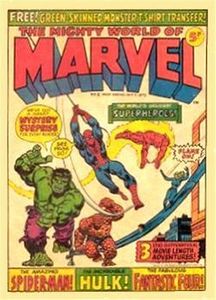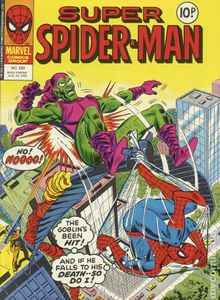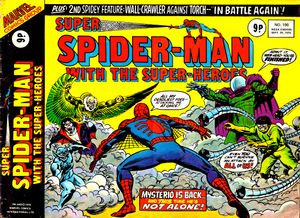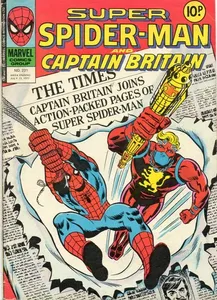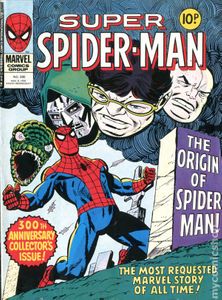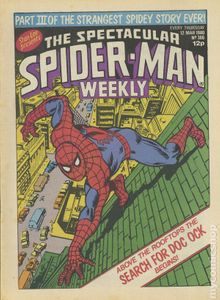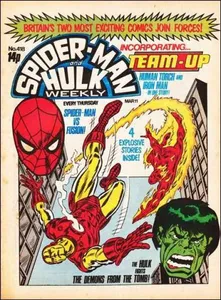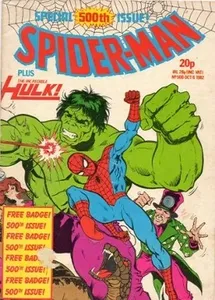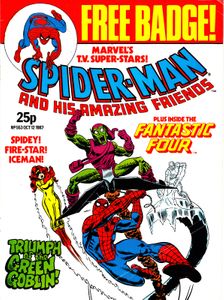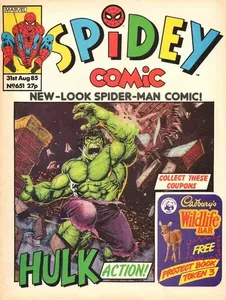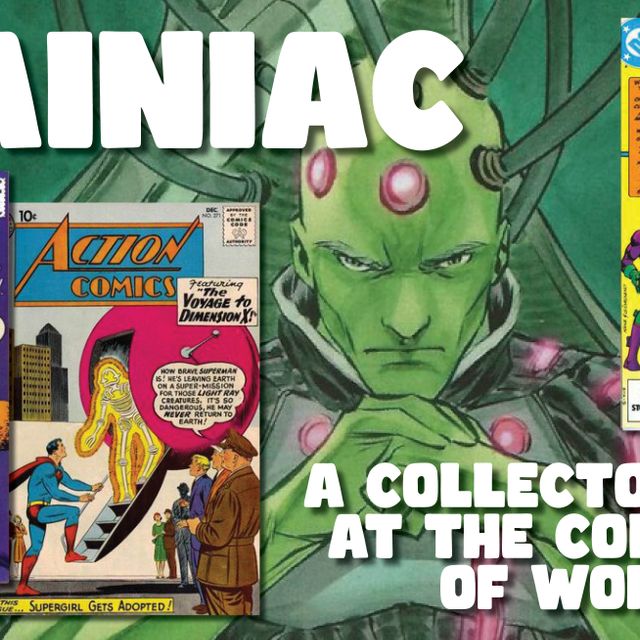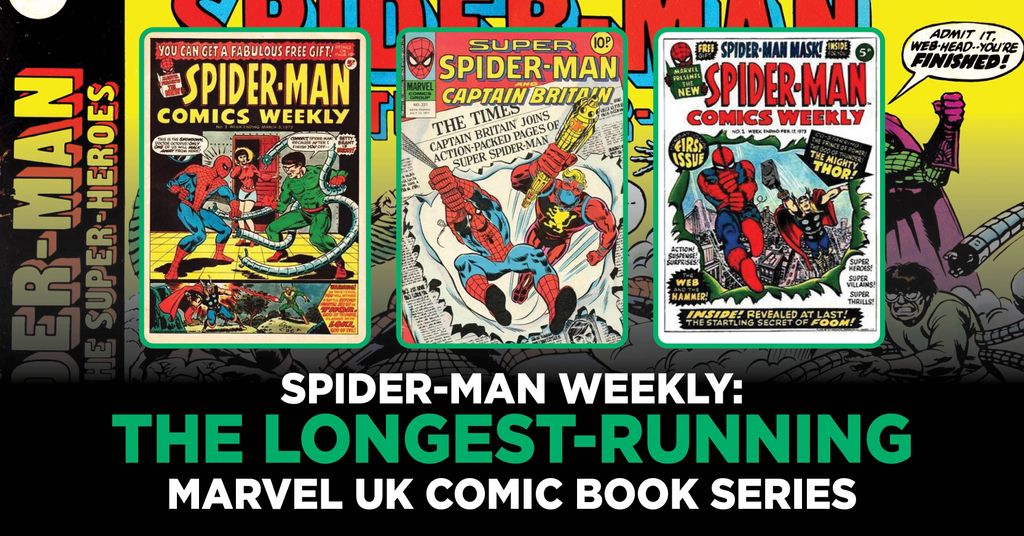
My previous articles on the subject include:
Now, I imagine you are all thinking: Surely there isn't any more to discuss regarding UK pence issues? Surely there aren't any more books to still go through? Lucky for us all, there is!
This week's article is all about a series very close to my heart: Spider-Man Comics Weekly (beginning in 1973).
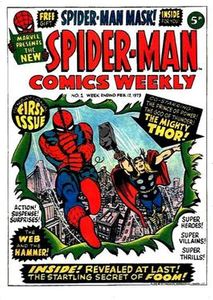
Spider-Man Comics Weekly helped Marvel gain a foothold in the UK weekly comic market, allowing the company to cross-market and later introduce non-superhero UK-reprint titles such as Planet of the Apes and Star Wars, two comic runs I adore and have fond memories of.Although it changed its title name several times over the years of publication (mostly due to other less successful Marvel UK comics merging with it), the Spider-Man weekly comic became the longest-running Marvel UK comic book series, with six hundred and sixty-six issues from 1973 to 1985 published.
The UK Spider-Man Comics Weekly Titles Included:
Super Spider-Man
Spider-Man stories within this run would be split up, usually running over two consecutive weekly issues to give a single complete story.
Super Spider-Man with the Super Heroes & Super Spider-Man and the Titans
In early 1976, the short-lived Marvel UK title The Super-Heroes was merged with Spider-Man Comics Weekly, changing the title to Super Spider-Man with the Super-Heroes.The book also changed orientation, changing from the standard portrait layout to a landscape format. This new design follows the lead of another relatively new Marvel UK title: The Titans, which also later merged with the Spider-Man series. Reader reactions were mixed, as it often made the text small and difficult to read.Super Spider-Man and the Titans gave readers a lineup of Spider-Man, Thor, Iron Man, The Invaders, Captain America, and the Avengers. The book continued using the landscape orientation until the penultimate edition of Super Spider-Man and the Titans (Issue #229), when it reverted back to the more traditional "portrait" format.
Super Spider-Man and Captain Britain
In late 1976, Marvel UK had debuted its first original weekly series, starring the British superhero Captain Britain. Captain Britain Weekly lasted 39 issues before it was eventually absorbed into the weekly Spider-Man run. The series changed its title again, this time to Super Spider-Man & Captain Britain.
Super Spider-Man
In 1978, British editor Dez Skinn was hired by Stan Lee to take over the now-dwindling Marvel UK project. Skinn decided to update all of Marvel UK's titles, including Spider-Man. He changed the title back to Super Spider-Man and gave it a new look, more similar to the outward appearance of a "traditional" British weekly comic.Original US artwork was reprinted, as in previous publications. Panels were often edited to both meet the lower page count and look more like existing British comics - chopped up, re-arranged, removed, and reduced.In addition to our beloved Spider-Man, the title featured five backup strips, starring the Fantastic Four, the Avengers, Thor, Nova, and the Sub-Mariner.
The Spectacular Spider-Man Weekly
In the summer of 1979, we witnessed the demise of the weekly comic formerly known as The Mighty World of Marvel and a new series was founded. The new title was called The Spectacular Spider-Man Weekly and featured backup stories featuring both Daredevil and Godzilla.

Marvel Weekly and Spider-Man and Hulk Weekly
Another Marvel character with great popularity in the UK was The Incredible Hulk. And after co-starring for many years in the pages of The Mighty World of Marvel, he was given his own weekly title: Hulk Comic. However, this was soon cancelled and so Hulk was, like so many others before it, merged into the Spider-Man title.Now renamed Spider-Man and Hulk Weekly, this run was backed up by stories featuring the two main characters' female counterparts: Spider-Woman and She-Hulk. The series also contained stories of The Defenders Team.
Spider-Man and Hulk Teamup
Spider-Woman and The Defenders were later replaced by Spider-Man team-up stories. The cover initially indicated the merger by being titled: Spider-Man and Hulk Weekly Incorporating Marvel Team-Up, but this was later abbreviated to just Spider-Man and Hulk Team-Up.
Spider-Man TV Comics
Between 1977 and 1979, tv audiences were given The Amazing Spider-Man live-action television series. This inspired yet another title change to the UK-based comic run, changing it to more of a magazine format with photo essays and reader comments. The format also changed to 28 pages with 8 pages of colour, which was a HUGE difference from others titles at the time, when almost all UK comics were still black and white. (Except for their covers.) These colour pages were printed on glossier paper and really were a game changer!
Spider-Man
With issue number #500, the title changed its name yet again. Now just going by Spider-Man, the page count was increased to 36 and additional backup stories returned.
Spider-Man and his amazing friends
The debut of the animated series: Spider-Man and His Amazing Friends, inspired the latest title change in October 1983.The logo remained the same, but the words "and His Amazing Friends" was added around it. Initially, the back-up strips were an adaptation of the first episode of the cartoon, co-starring Iceman and Firestar; these were soon replaced by Thor and the X-Men.
Spider-Man Comic
In late 1984, the British audience for the comic was becoming a lot younger, despite the readers of the American Spider-Man comics getting older. Reprinting stories featuring Spider-Man's controversial black costume, the UK team feared losing their younger readers and so soon stopped running reprints of the American material.Initially, the title began reprinting Spider-Man stories from give-away issues in US newspapers. Soon, these stories were replaced with tales for younger readers from the pages of the American title Spidey Super Stories, backed up by strips such as Wally the Wizard and Fraggle Rock from Star Comics.
Spidey Comic (1986)
With the August 1985 name change to Spidey Comic, the title solidified its targeting of younger children. And finally, in December 1985, the Spider-Man Weekly published its last issue. (Number Six Hundred and Sixty-Six)
I understand that this particular format for comics doesn’t appeal to most collectors, but for me (and I'm sure a few others out there) these books hold a very special place within our childhood memories.
Are you a fan? Have you even heard of these before? Let us know in the comments!

